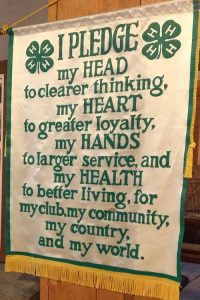4-H Pledge
 Our pledge banner is a contemporary banner included in the exhibit so our visitors can know the words all 4-H’ers pledge at every 4-H meeting and 4-H event. The history of the 4-H Pledge in the state of Maine mirrors its history in many states.
Our pledge banner is a contemporary banner included in the exhibit so our visitors can know the words all 4-H’ers pledge at every 4-H meeting and 4-H event. The history of the 4-H Pledge in the state of Maine mirrors its history in many states.
Club work began in Maine in 1913 and Maine Clubs, as was happening around the country, began to create their own Club Pledges very early. The one that became official nationally during the first National 4-H Club Camp in 1927 (I pledge my head to clearer thinking…) was written by the Kansas State 4-H Leader, Otis Hall, in 1918 (It was revised in 1973 when the words “and my world” were added.). The 1919 Extension Newsletter (V1, #13, page 3) introduced the “Kansas Pledge” to Maine 4‑H’ers by saying it “is a dandy!” However, even as late as 1926 Maine clubs were still creating their own. Here is an offering from 1926, noted in that year’s December issue of the state 4-H newsletter Echoes from Clubdom (v9, #6, page 1):
As an earnest club member I dedicate
My hands to honest labor,
My health to useful endeavor,
My head to straight thinking,
My heart to human happiness,
All in devoted loyalty to my club, my community, my State and My Country.
Although the club idea was first met with suspicion and resistance in communities, even among parents, as the idea proved itself over time, membership began to increase. To ensure the educational integrity of the Club, Extension developed national Club standards in 1918. In an effort to reach more young people, especially after WWI, Extension leaders placed greater emphasis on enhancing the members’ “sense of club”. In Maine, in addition to club pledges, 4-H’ers were encouraged to write club songs and club cheers. Use of the clover emblem and “To Make the Best Better” motto were encouraged nationally (they were already in use in Maine by 1915, earlier elsewhere) and national elements such as a pledge, a 4‑H flag, 4-H pins, 4-H colors (green and white) and, in some states, even “uniforms” were adopted.
